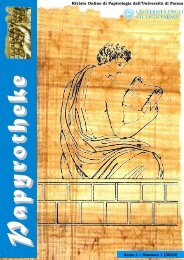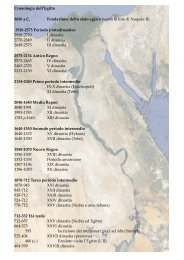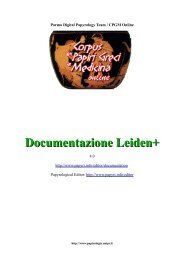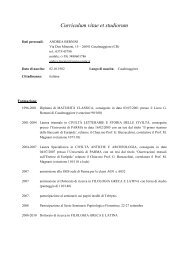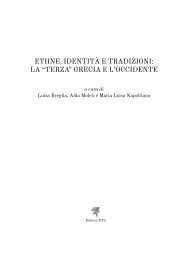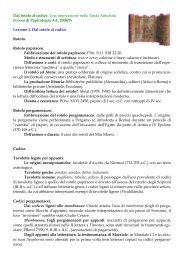The Michigan Medical Codex: P. Mich. Inv. 21 - Corso di Papirologia
The Michigan Medical Codex: P. Mich. Inv. 21 - Corso di Papirologia
The Michigan Medical Codex: P. Mich. Inv. 21 - Corso di Papirologia
You also want an ePaper? Increase the reach of your titles
YUMPU automatically turns print PDFs into web optimized ePapers that Google loves.
146 L.C.Youtie<br />
8 [ua TpLo c]X6uaCE X? Xp[V]<br />
4,5,6 Pap.J 8. ixct<br />
Translation<br />
<strong>The</strong> white plaster with rose oil: 1 drachm of fresh young pig fat, one<br />
fourth ounce of litharge, one-fourth oz. of birthwort Longa, one-fourth oz.<br />
of wax, one-fourth dr. of myrrh, 5 oz. of oil, the whites of three cooked<br />
eggs. Prepare and use.<br />
1. This line contained the end of the prece<strong>di</strong>ng recipe.<br />
2. <strong>The</strong> title of this recipe, "the white plas-ter with rose oil," is not<br />
duplicated exactly in any of the seven parallel texts.66) Galen's recipe, re<br />
ported by Heras as taken from Asclepiades, is called n 'Po6LcuXn, "the Rho<strong>di</strong>an<br />
plaster. " Aet. (1 ) has the title &AXn 'AcXXrTTtmLou 5o06vrLn XcLou0vLvn cXXCLcTln,<br />
with one MS calling it 'PO6LcLX. Orib. (1) and (2) are both called f 6L&<br />
_7v, "the plaster with eggs"; Aet. (3), "the plaster of Oribasius with eggs";<br />
that of Paulus, "the plaster with white lead, or, with eggs"; while Aet. (2)<br />
has the strange name, uxoTuX 67) For white plasters in general, see Gal.<br />
XIII 409-457.<br />
Our text does not give the purpose of the recipe, but it is found in three<br />
of the parallel texts. Galen and Aet. (1) and (2) describe it as a <strong>di</strong>spersing<br />
and healing remedy for hardened swellings of the breast, a good application for<br />
anal ulcerations, "and indeed all other ulcerations." 68)<br />
3ff. It is seen from the Table of Ingre<strong>di</strong>ents and Amounts that our text is<br />
most similar to that of Orib. (2), inclu<strong>di</strong>ng the omission of white lead. <strong>The</strong><br />
amounts of pig fat and oil are the same, while litharge and wax have 2 dr.<br />
each in our text, but only 1 dr. each in Orib. (2).<br />
3-4. [c]lTaLoc XOLpELou [lTpo]c&a[Tl]ou: "fresh young pig fat." Aet. (1) has<br />
c. 6CCoU T1., "fresh pig fat." Gal. has c. Ciou XCTELpyacLcEvoU, "prepared pig<br />
fat." i.e., fat from which the fibres and sinews have been removed. Cf. A,<br />
8-9, note. Orib. (2) has c. 66sXoU, and Aet. (2), c. xrivEsX?OU, goose fat. Orib.<br />
(1), Aet. (3), and Paul. omit the fat altogether.<br />
5. [&P]LCToXoXcx0c 4cLxpdc: For the several <strong>di</strong>fferent types of birthwort,<br />
66) <strong>The</strong> seven parallel texts are: Gal. XIII 448,11; Orib. IV 608,31 =<br />
Orib. (1); 615,24 = Orib. (2); Aet. XV, p.128,1 = Aet. (1); p.128,9 = Aet.<br />
(2); p.127,7 = Aet. (3); Paul. VII 17.26. See the Table of Ingre<strong>di</strong>ents and<br />
Amounts at the end of the commentary.<br />
67) Three of the six MSS of the text have OLXOTi5Xn. Cf. footnote 68.<br />
68) <strong>The</strong> full title of Aet. (2) is T DuxOTuXlUX 1-LXLcQL TLOLOOCCL TEPOC Tl. v<br />
6Q1xTUXOLC e'X}n )OL'L TdXAa 6pi TLaVTa. <strong>The</strong> OuxoTuXn of Paul. VII 17.32, although<br />
for the same purpose, is quite <strong>di</strong>fferent from that of Aet. (2), with other<br />
metals and many more ingre<strong>di</strong>ents.



